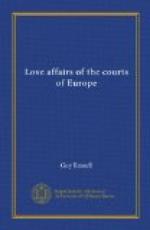Her early years were wrapped in a mystery which she mischievously helped to intensify by declaring that her father was a famous Spanish toreador. Her origin, however, was prosaic enough. She was the daughter of an obscure army captain, Gilbert, who hailed from Limerick; her mother was an Oliver, from whom she received her strain of Spanish blood; and the names given to her at a Limerick font, one day in 1818, two months after her parents had made their runaway match, were Marie Dolores Eliza Rosanna.
When Captain Gilbert returned, after his furlough-romance, to India, he took his wife and child with him. Seven years later cholera removed him; his widow found speedy solace in the arms of a second husband, one Captain Craigie; and Dolores was packed off to Scotland to the care of her stepfather’s people until her schooldays were ended.
In the next few years she alternated between the Scottish household, with its chilly atmosphere of Calvinism, and schools in Paris and London, until, her education completed, she escaped the husband, a mummified Indian judge, whom her mother had chosen for her, by eloping with a young army officer, a Captain James, and with him made the return voyage to India.
A few months later her romance came to a tragic end, when her Lothario husband fell under the spell of a brother-officer’s wife and ran away with her to the seclusion of the Neilgherry Hills, leaving his wife stranded and desolate. And thus it was that Dolores Gilbert wiped the dust of India finally off her feet, and with a cheque for a thousand pounds, which her good-hearted stepfather slipped into her hand, started once more for England, to commence that career of adventure which has scarcely a parallel even in fiction. She had had more than enough of wedded life, of Scottish Calvinism, and of a mother’s selfish indifference. She would be henceforth the mistress of her own fate. She had beauty such as few women could boast—she had talents and a stout heart; and these should be her fortune.
Her first ambition was to be a great actress; and when she found that acting was not her forte she determined to dance her way to fame and fortune, and after a year’s training in London and Spain she was ready to conquer the world with her twinkling feet and supple body.
Of her first appearance as a danseuse, before a private gathering of Pressmen, we have the following account by one who was there: “Her figure was even more attractive than her face, lovely as the latter was. Lithe and graceful as a young fawn, every movement that she made seemed instinct with melody. Her dark eyes were blazing and flashing with excitement. In her pose grace seemed involuntarily to preside over her limbs and dispose their attitude. Her foot and ankle were almost faultless.”
Such was the enthusiastic description of Lola Montez (as she now chose to call herself) on the eve of her bid for fame as a dancer who should perhaps rival the glories of a Taglioni. A few days later the world of rank and fashion flocked to see the debut of the danseuse whose fame had been trumpeted abroad; and as Lola pirouetted on to the stage—the focus of a thousand pairs of eyes—she felt that the crowning moment of her life had come.




